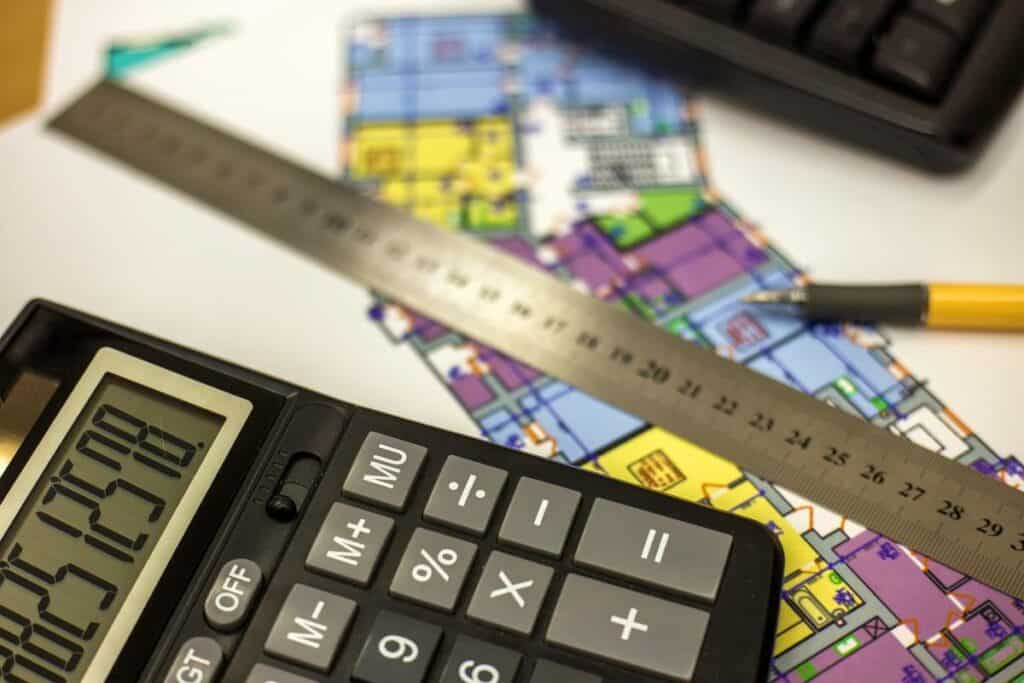Ever felt like a ship captain steering through foggy seas when trying to Determine Your Commercial Property Value? It’s tricky, right? One moment you’re confident about your direction. The next, doubt creeps in.
Navigating the commercial property market feels like deciphering a maze filled with jargon such as capitalization rates and gross rent multipliers. Sounds complex? Sure does. But here’s the thing: understanding these can turn the tide in your favor. Imagine knowing exactly what your property is worth. No guesswork.
This isn’t just about numbers though. Factors such as location and market trends play massive roles too. Every building tells its own story, influenced by its surroundings and how it stands out (or blends in).
Key Takeaways
- Think of commercial property as the backbone of business, crucial for growth and profit. Knowing its classification—Class A to C—unlocks an understanding of its value, impacting investment appeal and future financial prospects.
- Unlock your commercial property’s value with detective work: compare sales, analyze income potential, check construction costs, and consider rental income.
- Mastering cap rates, GRM, and NOI give you x-ray vision in commercial real estate, letting you spot the smartest investments.
Table of Contents
Understanding Commercial Real Estate Valuation
What is Commercial Property?
Think of commercial property as the stage where business dramas unfold. Spanning from towering office structures to snug street-side coffee shops, these locales transcend mere plots and masonry—they emerge as crucibles for creativity, trade, and expansion. They include retail spaces, offices, warehouses, and multifamily residential units that serve five or more families.
Distinguishing a commercial property from its residential cousin isn’t just about size or location; it’s about purpose. These buildings are mainly designed for earning through appreciation or leasing revenue, an essential factor in grasping their worth.
Why the Classification Matters
Identifying a commercial property’s category doesn’t just neatly organize it; it unveils the treasure trove of its possible worth. Imagine you’re at an auction where paintings are being sold by unknown artists versus Picassos; knowing which is which drastically changes your willingness to open your wallet. Similarly, whether a building is classed as Class A (high-end), B (middle-road), or C (needs work) impacts not only how much investors are willing to pay but also who might be interested in buying.
This classification system helps set expectations around maintenance costs, rent levels, and tenant quality—all crucial factors when calculating value.
How to Classify a Property
To pin down exactly what makes one building different from another requires looking at several factors: age and condition of the structure certainly play their parts but so do location desirability and technological readiness for today’s digital demands. An older building right in the heart of downtown with high-speed internet may outshine newer constructions on the city outskirts due to accessibility alone.
Taking all this into account can feel like juggling while solving Rubik’s cubes—complex but not impossible with practice and patience.
Methods for Calculating Commercial Property Value
Grasping what defines commercial real estate alongside why classifications hold such weight in valuing them properly opens up pathways toward making informed decisions—whether you’re selling tomorrow or planning future investments today.
LendingTree suggests that there are several methods to determine the value of a commercial property, including the cost, sales, income, gross rent multiplier, discounted cash flow, and price per square foot approach. The selection of the most appropriate method for a given property can depend on individual market conditions.
| Valuation Method | Description |
|---|---|
| Sales Comparison Approach | Compares the property to similar properties recently sold in the area, adjusting for differences. |
| Income Capitalization Approach | Considers the property’s annual income and divides it by the capitalization rate. |
| Cost Approach | Calculates the cost to construct an identical building from scratch, subtracting depreciation. |
| Gross Rent Multiplier Approach | Divides the sale price of comparable properties by their annual rental income before expenses. |
| Discounted Cash Flow Approach | Projects future cash flows and discounts them to present value using a target rate of return. |
| Price per Square Foot Approach | Divides the sale price of a property by its square footage and compares it to similar properties. |
Sales Comparison Approach
Finding the value of your commercial property feels a bit like detective work, and the sales comparison approach is your magnifying glass. This method looks at similar properties in your area that have recently sold. Think of it as shopping for a vintage car; you wouldn’t pay more for a model if others were selling for less right around the corner.
The key here is “similar.” You’ll need to adjust prices based on differences between your property and those comparables (or “comps”). If yours has better accessibility or more parking spaces, it might be worth more. Investopedia offers an excellent breakdown of how adjustments can affect valuation.
Income Capitalization Approach
If your commercial property generates income through leasing space, then this method will feel like fitting puzzle pieces together. The income capitalization approach considers how much money the property brings in annually and divides that by what’s known as a cap rate – essentially, the return investors expect on their investments.
To put it simply: higher income equals higher value but watch out because high expenses can eat into this figure faster than ants at a picnic. To understand these nuances better, Nolo’s guide breaks down each step neatly.
Cost Approach
This method plays off the idea: why buy something when you could build it cheaper? It calculates what it would cost to construct an identical building from scratch today—land price included—and subtracts any depreciation due to wear and tear or obsolescence over time.
The tricky part here is accurately estimating construction costs and depreciation rates without going overboard. Getting too imaginative with figures can lead you astray faster than following directions from an outdated map. Exploring the CCIM Institute’s wisdom offers a roadmap to precisely navigate the complexities of crunching construction costs and depreciation rates.
Gross Rent Multiplier Approach
Last up is akin to judging a book by its cover—or rather, its rental income potential alone without peeking inside at operating costs or net profit margins. The gross rent multiplier (GRM) approach takes the sale price of comparable properties and divides them by the annual rental revenue they generate before expenses are deducted.

Key Factors Influencing Commercial Property Value
Location and Accessibility
When it comes to commercial real estate, the mantra ‘location, location, location’ isn’t just a catchy phrase—it’s gospel. A prime spot can skyrocket your property value because businesses thrive on foot traffic, ease of access for customers, and proximity to suppliers or partners. For instance, properties near major highways or public transportation hubs are gold mines due to their accessibility.
But there’s more than meets the eye with location. Neighborhood dynamics—like safety ratings and local amenities—also play a crucial role. A business next door to a popular coffee shop? That could mean more eyes (and wallets) walking past your doorstep every day.
Physical Characteristics of the Property
The bones of your building matter—a lot. Modern infrastructure that supports today’s tech needs is non-negotiable for most enterprises. Think high-speed internet capabilities and energy-efficient systems which not only attract tenants but also reduce operational costs in the long run.
Aesthetics count too; first impressions can make or break potential lease agreements. Properties boasting unique architectural elements or well-maintained exteriors often stand out from the crowd. Regular maintenance is key here; it preserves both functionality and curb appeal.
Income Potential and Rental Rates
Rental income is the lifeblood of commercial real estate investments. The potential for earning competitive rental rates makes certain properties hot commodities—especially those that offer flexible space solutions catering to various tenant needs.
To get ahead, staying updated on market trends, like co-working spaces’ rise in popularity among startups looking for low-commitment office solutions will let you adjust offerings accordingly.
Market Conditions and Trends
Economic factors such as employment rates in an area directly impact commercial property values since they influence companies’ expansion or contraction plans—and hence demand for space. Moreover, emerging industry sectors might be scouting locations offering specific advantages, signaling lucrative investment opportunities if timed right. Understanding these broader economic indicators requires keeping an ear close to the ground through reliable sources such as U.S News Real Estate section.
Trends also dictate what kind of facilities are en vogue; currently, green buildings promoting sustainability find favor among environmentally conscious tenants who prefer doing business in places reflecting their values. The pivot to sustainable methodologies is carving out fresh pathways, enriching properties with additions such as photovoltaic cells and systems for collecting rainwater.
Working with Professionals in Property Valuation
Role of Real Estate Agents in Valuation
Finding the right value for your commercial property feels a bit like solving a complex puzzle. But, here’s where real estate agents shine. They’re not just salespeople; they’re local market experts whose insights can be invaluable.
A seasoned agent brings to the table an intimate knowledge of the area and its history, giving you an edge by understanding what makes properties in your locale tick or tank. It’s this depth of knowledge that allows them to compare apples to oranges effectively when looking at different properties through the sales comparison approach.
Moreover, their network is often as valuable as their expertise. A well-connected agent can provide introductions to potential buyers who are already interested in similar properties or even bring attention from investors outside your immediate market.
Importance of Appraisers in Determining Value
An appraiser steps into the valuation ring armed with objectivity and a calculator ready for battle against subjectivity. Their main weapon? The income capitalization approach among others, which calculates your property’s worth based on its ability to generate revenue—a crucial figure if income potential is your property’s strong suit.
In their evaluations, they meticulously explore factors like the appeal of the location, the present state compared to maintenance expenses, and how similar properties in proximity fare against each other—extending these comparisons into forthcoming times as well. By meticulously examining every nook and cranny, this in-depth scrutiny guarantees you’re capturing the full monetary value your property merits, preventing any potential oversight from costing you.
To make sure their valuations hit home run accuracy levels every time they step up to bat, professional appraisers stick strictly to guidelines set out by authoritative bodies such as The Appraisal Institute. This adherence safeguards both sellers and buyers against bias or error—making it clear why bringing an appraiser onto your team early could save headaches down the road.
Understanding Metrics in Commercial Real Estate Valuation
Capitalization Rates
The capitalization rate, or cap rate for short, is a metric that can make or break your commercial real estate deal. Think of it as the potential return on investment (ROI) you might expect from a property. Calculating the cap rate involves dividing the net operating income by the current market value of the property. A higher cap rate suggests a potentially higher ROI but also comes with higher risk.
To get into specifics, if a building brings in $100,000 annually after expenses and is worth $1 million, its cap rate would be 10%. This simple percentage gives investors at-a-glance insight into their possible earnings relative to their investment size.
Gross Rent Multiplier
Moving onto another critical figure: The Gross Rent Multiplier (GRM). This metric tells us how many years it’ll take for the property to pay for itself through rental income alone. You calculate GRM by dividing the price of the property by its annual gross rental income. It’s straightforward yet powerful because it helps quickly assess if a price tag matches up with earning potential.
A lower GRM indicates that you might recoup your initial investment faster than properties with higher multipliers—a key factor when deciding between different opportunities.
Net Operating Income
Last but certainly not least is Net Operating Income (NOI), arguably one of those numbers that keeps investors up at night—for good reason. NOI represents what’s left from your rental revenue after subtracting all necessary operational costs except financing/mortgage costs. This measure acts as a crucial barometer for your property’s fiscal wellness and earnings prior to accounting for debt obligations.
An increasing NOI over time signifies growing profitability and potentially appreciating asset value; conversely, a decreasing NOI could signal trouble ahead regarding either decreased revenue or increased expenses—or both.
Digging deep into these metrics will let you gauge not just any commercial real estate’s present worth, but more importantly, reveal insights about future performance. Now that you’ve got this intel, you’re all set to make some really smart investment moves. Sure, the math behind valuation isn’t always sexy, but understanding these three vital signs—cap rates, gross rent multiplier, and net operating income—is like having x-ray vision in a world where only smart money wins big.

Protecting Your Commercial Property’s Value
Maintenance and Upkeep
Think of your commercial property like a vintage car. Just as you regularly tune up the engine and polish the exterior to keep it running smoothly and looking its best, similar care is essential for your building. Regular maintenance not only prevents costly repairs down the line but also significantly contributes to preserving your property’s value.
Keeping a property in top shape not only makes it more appealing but also draws in better tenants ready to shell out extra cash for a spot that’s both aesthetically pleasing and runs like clockwork. This means prioritizing both interior updates—like modern lighting fixtures or efficient HVAC systems—and exterior upkeep such as landscaping, facade improvements, and parking lot maintenance.
To preemptively tackle potential problems, establish a regular schedule for conducting thorough inspections. Check roofing, plumbing, electrical systems, and other critical infrastructure regularly. And don’t forget about cosmetic touch-ups; fresh paint or updated signage can work wonders on first impressions.
Market Research and Trends
In real estate investment circles they say “location” three times for emphasis because it matters that much—but so does timing influenced by market research and trends. Grasping the nuances of neighborhood market shifts is key to making savvy choices on whether it’s prime time for enhancements or a strategic shift, aiming to up the allure of your property as tenant tastes evolve.
The right enhancements at the right time can boost rental income; for example, navigating towards green technologies and sustainability initiatives could attract eco-conscious businesses looking for modern spaces reflecting their values.
To stay ahead, it’s crucial to immerse yourself in the latest market intel by exploring resources such as detailed analyses of commercial property trends. Whether it’s embracing coworking spaces due to rising demand from startups or upgrading digital infrastructure for tech-savvy companies—you’ll want your finger on the pulse of what makes properties stand out in today’s competitive landscape.
Remember: The effort put into maintaining every aspect of your commercial property doesn’t just safeguard its condition—it directly influences its ability to generate income now while bolstering long-term value against future market fluctuations.
FAQs
How do I calculate the value of a commercial property?
To figure out a commercial property’s worth, compare it to similar sold properties, check its income potential, or assess replacement costs.
How is commercial property valued based on income?
We look at the money it makes. Subtract expenses from gross rental income to get net operating income; apply cap rate next.
What is cap rate on commercial property?
The cap rate shows the expected return on an investment, calculated by dividing net operating income by current market value.
What is a value in CRE?
In Commercial Real Estate (CRE), ‘value’ means how much a building could sell for today based on its features and earning power.
Why is determining the fair market value of commercial property crucial for investors?
Determining the fair market value of commercial property is crucial for investors as it helps them make informed decisions on investing in commercial real estate and understanding the potential returns on their investment.
How does a commercial appraisal help in determining the value a commercial property?
A commercial appraisal involves a thorough evaluation of the property based on market conditions, income potential, and property type, which helps in accurately determining the value of the property.
Conclusion
Calculating the fair market value of commercial properties requires a thorough understanding of various valuation methods and the factors that influence property values. By carefully analyzing comparable properties, applying appropriate capitalization rates, and utilizing the sales comparison approach, you can develop a well-informed assessment of a property’s worth.
Remember, each property is unique, and it’s essential to consider its specific characteristics and market conditions when determining its value.
If you have any questions or would like expert guidance in valuing your commercial property, don’t hesitate to schedule a consultation with me. We’re here to help you navigate the complexities of commercial real estate valuation with confidence and clarity.




